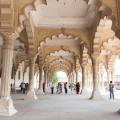AGRA FORT
Majestic red sandstone fort built by Emperor Akbar and transformed into a palace by his grandson Shah Jahan
This majestic red sandstone fort was built by Emperor Akbar in 1565 when he was only 23 years old. His grandson Shah Jahan transformed it into a palace, and it was Aurangzeb who added the final touch: the outer ramparts. The presence of a fort in Agra dates back to the end of the 11th century. It was here that Humayun was crowned emperor in 1530. From the red sandstone volumes of Akbar to the inlaid marbles of Shah Jahan, the fort is marked by the styles of the different rulers who have refined this place. It has many similarities with the Red Fort of Delhi, but it is much more accomplished and delicate. Access is through the impressive Amar Singh Gate to the south of the citadel. After having gone up the paved ramp, you arrive on a huge esplanade. Don't be surprised to see signs forbidding access to certain areas, as the fort is still occupied by the army.
Jahangir Mahal. On the right as you enter the fort stands the Jahangir Palace, topped by two white-roofed chhatris. Built by Akbar, this palace was the main zenana, the quarter reserved for women. The huge bowl in front of the palace entrance was carved out of a monolithic block. Inside you enter a courtyard sheltered by a canopy. It was the royal room that one must imagine dressed with hangings, carpets, furniture. In the next room, the boxes in the walls served as a library. On the way out, you stand on the wall of the fort from where you can see the Taj Mahal. On the left, you enter another small room with a surprising acoustic phenomenon. It takes two people to take the measure of it, each one standing at a diametrically opposed angle. One whispers towards the wall, and on the other side of the room, the other listens. The sound travels up the arch of the vault and back down to the listener. An air conditioning system was also provided to cool the palace walls in the summer. Pipes ran through the walls, bringing coolness.
Khas Mahal. The style of this small palace shows the evolution of the architecture between the reign of Akbar and that of Shah Jahan. It was built between 1631 and 1640 for two of the emperor's daughters. The two almost identical pavilions are separated by a central hall. While the pavilions are made of red sandstone covered with white plaster, the central hall is all marble. The central pavilion opens onto a Mughal garden, theanguri bagh, with a large pool.the side pavilions display rich floral and geometric motifs. Blue and gold, the royal colors, were used abundantly and some traces of them can still be seen on the walls.
Shish Mahal. This other marble palace was also built by Shah Jahan. The two main rooms, connected by a wide central arch, have two marble basins, probably royal baths. The palace is entirely decorated with mirror chips from Aleppo. The interior is deliberately dark requiring the use of candles that were reflected in the mirrors, creating an effect worthy of the Arabian Nights.
Musamman burj. This hexagonal tower preceded by a richly ornamented room is said to have been built by Shah Jahan for Mumtaz, his favorite wife. All in white marble, the main room is decorated with pietra dura, inlays of colored semi-precious stones forming floral patterns. From the tower, the view of the Taj Mahal is breathtaking. This is where Shah Jahan was imprisoned for the last 5 years of his life by his son Aurangzeb.
Diwan-i-khas. It is the private audience room of the emperor, built in 1637. Of red sandstone veneered with white marble, the columns and capitals are decorated with pietra dura. On the esplanade is the throne of Jahangir. Made in Allahabad, the black onyx stone comes from Belgium. On the edge, Persian inscriptions dating from 1602 indicate that Jahangir seized power before the death of his father Akbar.
Macchi Bhavan. The terrace of the Diwan-i-khas dominates this vast courtyard. It served as a place of entertainment for the emperor. The garden, located one level below, was equipped with a large pond containing fish. The square courtyard is laid out on two floors with galleries with columns. The first floor is made of red sandstone while the first floor was plastered with white. This is also where the treasure of the court was kept.
Nagina Masjid. This small mosque all in white marble is one of the jewels of Agra Fort. Built by Shah Jahan to serve the women of the court, the decorative restraint is in order. A simple three-arched pavilion topped by three domes backs onto the courtyard wall. A balcony overlooking the street and the Mina bazaar allowed the women of the court to shop without being seen.
Diwan-i-Am. The public audience hall allowed Shah Jahan to address his ministers and the nobility. The hall is made of red sandstone covered with plaster made of shell powder. The hall is divided into three aisles separated by arches and columns. The central elevated alcove allowed the emperor to address his audience. From here he could see the entire audience without being disturbed by the pillars of the hall. The alcove or jarokha is made of white marble and richly decorated. On each side, grilled windows allowed the women of the court to attend the audiences.
Did you know? This review was written by our professional authors.
Book the Best Activities with Get Your Guide
Members' reviews on AGRA FORT
The ratings and reviews below reflect the subjective opinions of members and not the opinion of The Little Witty.




여기도 타지마할 처럼 셀카봉 반입 안돼요
매표소옆에 짐 맡기는 곳 잇어요